The Emerging Channel Space Race: All the (Possible) Next Big Things, From Connected Car Notifications to VR Messages
Published on October 10, 2019/Last edited on October 10, 2019/20 min read


Todd Grennan
Content Production Principal, Content Marketing at BrazePicture this: It’s 2009 and your friend (you know the one) is gushing about iOS 3.0 and how it’s going to let apps send a whole new kind of message called “push notifications.” You smile and nod, but inside you’re thinking, “Who’s going to agree to let companies interrupt their phone time with a bunch of messages? I’ll just double down on sending email.”
Or, how about this: It’s 2016 and your team is clustered around a computer watching the keynote from F8—everywhere you look it’s chatbots, chatbots, chatbots. It’s instantly clear to you that this is it, the next big thing. You book a meeting with your engineering team and insist to them, “This is the future, people! We need bots that can chat!”
Admit it: Predicting the future is hard. This year’s hot messaging channel can easily end up as tomorrow’s also-ran—but it can also end up being transformational, something that reshapes entire industries and alters the contours of everyday life. The trick, of course, is knowing when a new channel is primed for greatness versus when it’s overhyped.
We’re here to help.
At Braze, messaging channels are our bread and butter. Our customer engagement platform is built to be both channel agnostic and capable of supporting seamless cross-channel engagement, so differentiating which new channels are ready for primetime, on the cusp, and which are still more concept than execution is central to our business. So sit back and let us catch you up on what’s happening with today’s emerging channels and what it means for the future of your engagement strategy.
The Classics: Mobile Channels, Web Channels, and Email
Let’s keep this short. When it comes to digital channels for engaging your customers in today’s fast-moving, mobile-first world, there are six stand-outs:
- Email — The original and still maybe the best. This flexible channel can support messages long or short, visually rich or simple and spare, broadly targeted or individually personalized, making it easy to reach and engage your audience. Plus, with Google’s AMP for Email, we’re seeing the introduction of rich, interactive content experiences (more on that later…).
- Push Notifications — Perfect for brief, immediate calls to action, these attention-grabbing mobile messages allow brands to reach people wherever they are and no matter what they’re doing.
- In-App Messages — This channel allows marketers to deliver messages exclusively to users actively engaged with their app, making them the perfect complement to email and push notifications.
- Short Message Service (SMS)/Multimedia Messaging Service (MMS) — Popularly known as “text messages,” SMS fills a key niche by allowing marketers to reach users in areas where mobile apps and email aren’t as dominant, as well as by supporting two-way interactions.
- Web Push Notifications — These web-based messages allow marketers to reach their audience on desktop and mobile web with short, snappy communications, even if the recipient isn’t currently on their webpage.
- In-Browser Messages — Like in-app messages for the web, in-browser messages allow brands to surface personalized, targeted outreach to active web visitors to deepen their engagement.
If you’ve been in the customer engagement space for more than a few months, these messaging channels are probably already on your radar—but that doesn’t necessarily mean you’re using them yet. That said, if you’re only using one channel (email, say, or push) to communicate with your users, you may be missing out on a massive amount of engagement: Braze research has found that cross-channel messaging can lead to as much as a 844% lift in engagement.
The Rising Stars: From Content Cards to Digital Direct Mail
Say hello to the up-and-comers of the customer engagement world. They’ve got hype, they’ve got promise, but while all of them exist out in the real world and are used by some brands to support their larger marketing strategies, they haven’t seen widespread adoption.
Sometimes it’s a regional thing (maybe APAC consumers love a specific channel, but EMEA consumers aren’t even aware of it); sometimes adoption is industry-specific (so every retail brand worth its salt is already using this channel, while no major companies in media and entertainment have given it a shot); and sometimes it’s simply about awareness—just because a channel exists doesn’t mean that marketers are up to speed on what it does and how to leverage it.
For marketing, growth, and engagement teams, the key question is: How much potential does each of these channels have, and does it make sense to try some of them out?
Content Cards
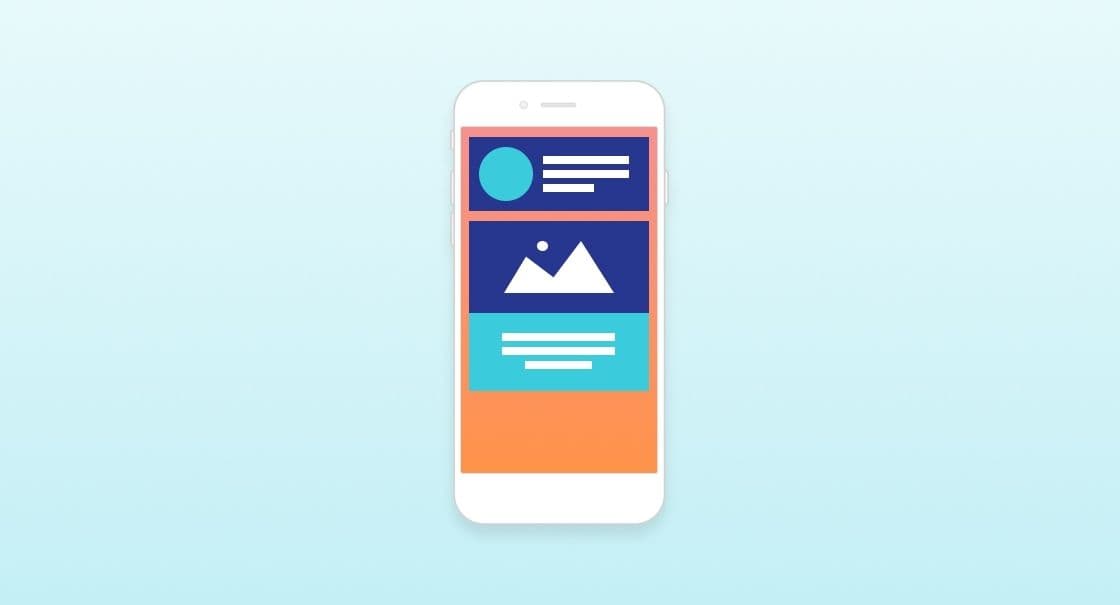
Some channels are all about grabbing your customers’ attention out in the world to pull them back to your app or website or other digital properties. Others are focused on communicating effectively with people after they’ve engaged. Content Cards—also known as “Feeds” or “News Feeds”—sit firmly in the latter camp, helping support great customer engagement by allowing brands to create persistent content within the mobile apps and websites that their customers love.
This channel is extremely flexible, making it possible for you to completely customize the look of your feeds and cards—and tailor their visual appearance to match the app or website they exist within. Because it’s designed to allow brands to highlight persistent content within their app or web experiences, it’s a powerful tool for encouraging users to immerse themselves in your brand experience. From onboarding new users with a eye-catching welcome flow on your website to creating an automatically updated promotional feed in your app, Content Cards complement interruptive channels like email and push notifications, which allows brands to keep the conversation going across different touchpoints to support a cohesive brand experience. (For more information on Content Cards, check out our exclusive overview.)
The Verdict: If you have an app or website, it’s worth considering.
Wearables Notifications

Wearables notifications have been in the spotlight since the launch of the Apple Watch back in 2015—and ever since, there’s been a debate about whether the messages you receive on wearable devices are distinct from the push notifications you receive on your phone. Apple, for instance, treats them as a subset of push and has set things up so that notifications can be delivered either to a users’ iPhone or to their Apple Watch, but not both; the messages only appear on your Apple Watch if your iPhone is unlocked. That means that whether or not your users own wearable devices will likely dictate whether you’re sending this kind of message.
Whether or not you consider wearables to be a distinct messaging channel, there’s no denying that the user experience that comes with them is quite different than a phone buzz in your pocket. Push notifications sent to wearables are necessarily more intimate than the ones received on your phone—making them harder for users to ignore, but also increasing the chances of people getting frustrated if you send them irrelevant or too-frequent messages. To make the most of wearables notifications, be thoughtful about all of your push sends. By keeping messages short, relevant, and impactful, you can communicate more effectively with customers whether the message shows up on their phone or on their wrist.
The Verdict: You may already be sending these messages—so be smart about how you do it.
AMP for Email
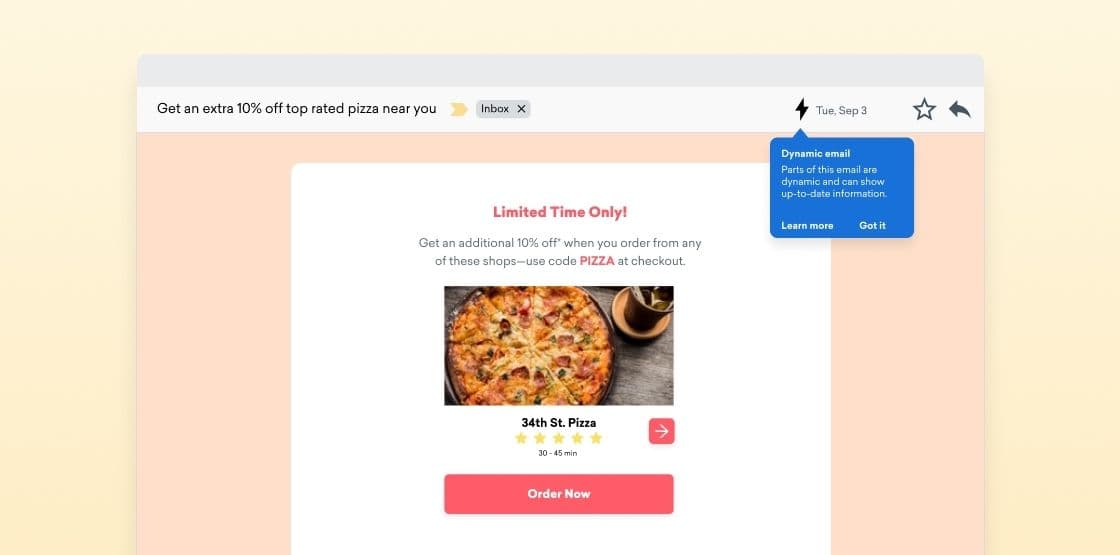
Like RCS, AMP for Email represents a significant evolution of a major existing channel—in this case, by allowing marketers to reach their existing email audience with richer, interactive experiences that can exist entirely within the inbox.
AMP, which stands for “Accelerated Mobile Pages,” was first announced by Google back in 2016 in order to speed up content load times and support a better user experience on the mobile web; AMP for Email takes the concept behind AMP and applies it to today’s email inbox. Google announced a spec for AMP for Email in its spring 2018 Gmail Developer Preview with the stated goal of helping to support more engaging and interactive emails.
AMP for Email makes it possible for marketing, growth, and engagement teams to send emails that support in-message interactions and—by definition—provide a more seamless user experience. Use cases to explore: Allowing recipients to swipe through dating profiles, complete and submit surveys, or schedule an appointment without ever leaving the inbox. That said, taking full advantage of AMP for Email today requires marketers to be comfortable using HTML and related code to build out the rich experiences they send, or to work hand-in-glove with their engineering teams to support their efforts. Also, AMP for Email is currently only available for users with Gmail and Mail.ru, though both Microsoft Outlook and Yahoo! Mail are expected to support the functionality soon.
The Verdict: Promising as all get out, but still coming into its own; it’s not for the code-averse, so make sure you have the right development support before exploring.
Digital Direct Mail

Direct mail marketing has existed for decades, but it’s traditionally operated in a silo of its own, disconnected from the rest of that brand’s customer engagement efforts. But as digital messaging became increasingly central to the way that brands communicate with their customers, a funny thing happened: It became possible to use technology to make direct mail a physical, tangible, eye-catching part of a digital-focused customer engagement strategy.
Back in the day, if a brand wanted to personalize the direct mail they sent, they had to print the bulk of the message with one system and then add in any personalized elements with a second, which created inefficiencies and opportunities for error. That changed with the rise of industrial-scale digital printing, which made it possible to print direct mail on an individualized basis, and integrations between digital customer engagement platforms and digital direct mail solutions. This made it possible to trigger the sending of personalized postcards the way you trigger personalized push notifications.
Digital direct mail brings the targeting and personalization that digital messaging made possible to the direct mail space. That could mean adding direct mail to your cross-channel lifecycle engagement strategy, or using them to reinforce messages or promotions being highlighted in your digital or social media ads. Keep in mind, though, that digital direct mail is still mail, and subject to the same sorts of timeline issues that mail has always had. If you want to test, tweak, and optimize your messaging, direct mail isn’t built to do that as quickly or efficiently as digital options.
The Verdict: Whether or not digital direct mail makes sense for your brand will probably depend on your vertical, the audience you’re trying to hit, and the use cases that matter for your business. For retail, it may well be key channel—but if you’re a mobile gaming app, maybe not.
Frontier Tech: Tomorrow’s Messaging Channels...Or Are They?
All right, here’s what you’ve been waiting for—the weird stuff. While a number are tied to exciting ideas or big new digital platforms, they’re all a bit out there compared to, say, email. Some of these channels are still in their infancy, with few brands taking them seriously; others are little more than in-progress technical standard or an exciting concept for channel-heads to jaw about over beers. That said, like most things in their early stages, they’re also full of mystery and promise.
This examination is, by its nature, a snapshot. Most of these channels are still growing to their full height, and even if you wanted your company’s customer engagement strategy to go whole hog on one of them, you’d struggle to do so. The audiences, technologies, and infrastructure isn’t quite there yet. But if you’re serious about watching for channels as they emerge, these are the ones to keep an eye on.
RCS
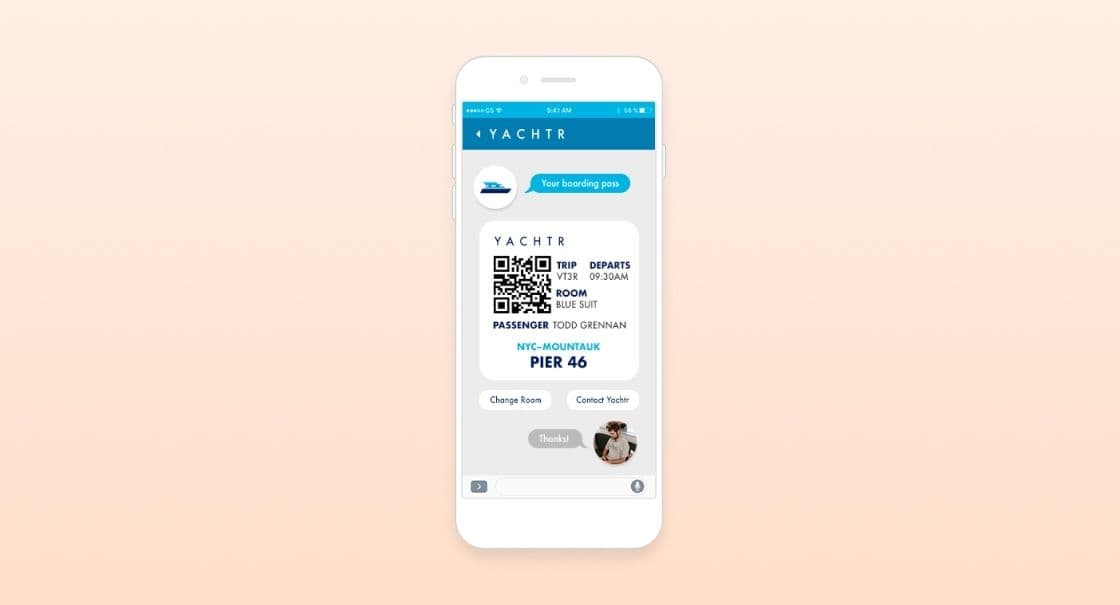
We’ve already talked about SMS, but not it’s younger, lesser-known sibling: Rich Communication Services (RCS). This channel—first conceived all the way back in 2007—was intended to push beyond the text-focused nature of SMS and bring richer context to text messaging, including both personal communications and marketing outreach from brands. Because RCS runs over telecom lines, as opposed to the internet, it has the potential to reach users with non-smartphones or in areas of the world with limited connectivity. Adoption remains stubbornly low because the rollout has required individual telecoms and original equipment manufacturers (OEMs) to support the standard in order to make sending these messages possible.
That said, help may be on the way. Back in 2015, Google elbowed its way into the space with the purchase of major RCS vendor Jibe and while the acquisition didn’t lead to an immediately spike in activity around this messaging channel, the tech giant recently signaled that it’s taking RCS seriously and will be taking steps to up adoption. Since June 2019, Android users in France and the United Kingdom are able to bypass their carriers and enable RCS support supported directly by Google. The program is believed to be part of a larger effort on Google’s part to give more Android users access to RCS, but global adoption still seems to be a ways off.
The Verdict: Worth considering in certain markets, but not ready for primetime most places.
Smart Speaker Notifications

In the five years since Amazon Echo pioneered a whole new product category (inspiring the creation of Google Home, Apple’s Homepod, and more), we’ve seen smart speakers play a bigger role in people’s day-to-day lives. More than 66 million smart speakers have been sold in the U.S. as of December 2018, nearly double the adoption seen two years earlier. But the ubiquity of these devices and the personal digital assistants (Alexa, the Google Assistant, Siri, etc.) hasn’t translated into a widely adopted messaging channel, the way that smartphone begat the push notification.
It isn’t that smart speakers can’t support messages: In fact, Amazon introduced notifications for Alexa all the way back in 2017, and opened it up to third-party brands from day one. But because smart speakers require users to take action to start engaging with them, the notifications are subtle in nature. Instead of Alexa barking at you from across the room about the latest promotion from your favorite retailer, your Echo will display a yellow light to let you know that there are messages awaiting your attention. For users to actually hear those notifications they have to ask Alexa to play them. (Both Google Home and Homepod also allow notifications, but generally only from services associated with Google and Apple, respectively, though users can choose to relay notifications from other devices to their Homepod.)
The upshot? Brands can use smart speaker notifications to communicate directly with users—but the experience can feel at times like a hi-tech version of checking your voicemail. Worse, because these notifications are specific to a device that generally sits in people’s homes, messages in this channel will generally need to be part of a larger cross-channel campaign to ensure that recipients don’t miss out on anything timely.
The Verdict: Great for low-urgency, home-focused messages; otherwise, you’re probably better off sending a push notification.
Connected Home Messages
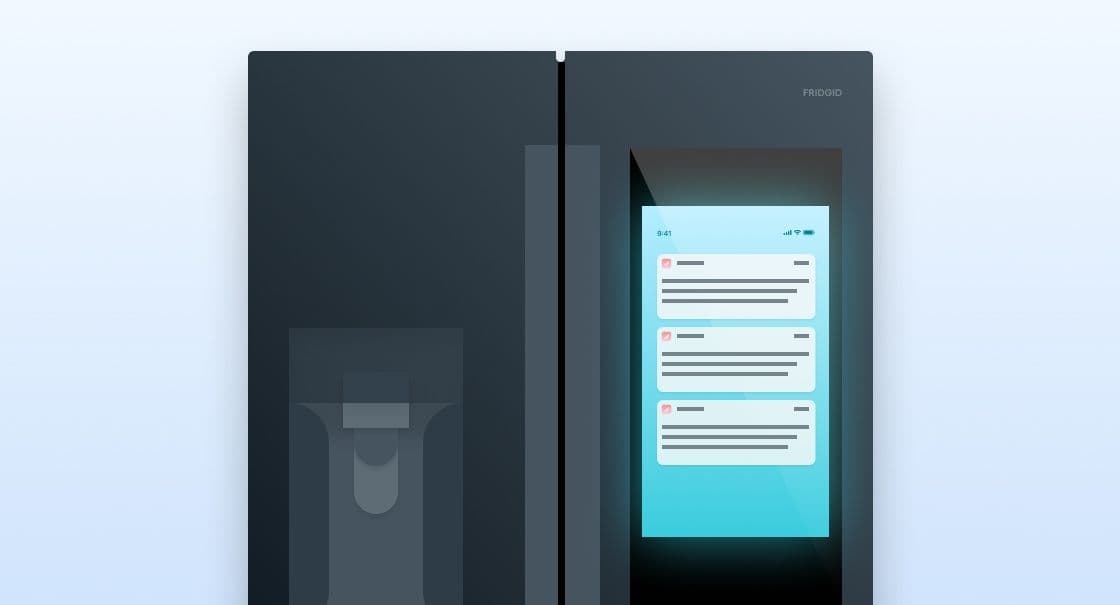
While people have been talking about the Internet of Things (IoT) since 1999—and thinking about a world of connected devices for even longer—one of the first places where we’re seeing it play out in real life is in the so-called Connected Home. As the number of homes using household smart devices grows at a compounded annual growth rate of 31%, the potential is there for Connected Homes to become a major digital platform separate from smartphones and computers. But whether or not they become vectors for brand-to-consumer communications is yet to be determined.
Today, notifications for Connected Home devices like smart lights, smart locks, and other smart devices are generally delivered via mobile push notifications (or other existing messaging channels) powered by the smart device’s native mobile app. However, Connected Home devices like smart fridges that have built-in screens could potentially become messaging centers in their own right, displaying third-party outreach similar to in-app messages while users engage with a given application.
That said, today’s Connected Home is often full of fragmented technologies unable to communicate effectively with other devices, especially those made by competing brands. That makes Connected Home messaging a fraught proposition—after all, your smart door may not know that your smart lights have already sent you three messages today, making the risk of over-messaging very real.
The Verdict: Wait and see until these technologies can talk more effectively—and whether on-device Connected Home messaging becomes widespread.
Smart TV Notifications

It’s already possible to gather data on how your brand’s users are engaging with smart TVs and OTT media platforms—Braze, for instance, has SDKs for Roku and Apple TV that can support that kind of activity. But as with Connected Home messaging, most of the current messaging possibilities associated with these devices aren’t about putting notifications onto the Smart TV’s screen; they’re about using the data you’re collecting from these devices to trigger relevant, responsive push notifications and emails based on how a given user is engaging. These second-screen messages can do a lot to drive stronger engagement based on a richer understanding of user actions, but they’re less a new channel and more a way to make existing channels more impactful.
Some smart TVs have already made moves towards supporting third-party notifications. The Amazon Fire TV, for instance, allows multiple potential message types, including “heads-up notifications”—those floating windows that appear at the bottom of the TV screen and disappear if users don’t engage with them—and “toasts,” which function like limited in-app messages and don’t allow for user interactions. However, there’s little indication that the existence of this functionality has led to any significant adoption by marketers.
Smart TV notifications also have some built-in complications. Because television viewing is often a communal experience and most TVs are located in people’s homes, knowing which individual is watching a given show (and, by extension, receiving a given on-screen message) can be difficult. Services that have distinct logins for different users within a given residence could potentially target different messages to different users, but privacy is still a concern—unlike smartphones, where brands can generally assume that a push will be seen by the phone’s owner, smart TVs may still be watched by a group even if a particular user was the one to log in.
The Verdict: Second-screen messaging is something to start thinking about; on-screen messaging is still in its infancy and will need some time before it’s anything you can build a customer relationship around.
Connected Car Messages

While the first connected car arguably dates back to 1996—when the first in-car service was launched to make it possible for drivers to request emergency help following an accident or other issue—modern connected vehicles have moved beyond the old-school cellular systems of that era to allow for high-speed data connections reminiscent of today’s smartphones. And with the expanding numbers of internet-connected cars, it’s becoming possible to imagine a world where individual apps function on screens within cars the way they already do on smartphones and computers. That opens up the possibility of data collection via SDK, second-screen messaging like you’ve already seen with Smart TVs, and maybe even on-screen Connected Car notifications.
A couple key caveats. First, most of today’s passengers are going to have a smartphone on hand whenever they’re in a car, so good old-fashioned push notifications may well proved to be just as good a way to reach them as messages delivered to an in-car screen. Second, there are some major safety concerns that come with sending Connected Car messages that you don’t intrinsically face when delivering outreach to, say, a smart toaster. Distracted driving caused by using mobile devices in the car already kills thousands of people every year, and no brand wants to have a customer’s death on their conscience—especially when all they were trying to do was tell them that they had a brick and mortar location half-a-mile up on the right. To reduce the impact of this issue, Apple Carplay and Android Auto both give users the ability to have texts (and in the case of Carplay, notifications from some Apple apps) read aloud instead of being displayed onscreen. However, neither service supports the reading of longer messages like emails, presumably because of concerns that doing so would be too distracting.
The Verdict: Keep your foot on the brake, at least until self-driving cars become a regular part of everyday life.
AR and VR Notifications
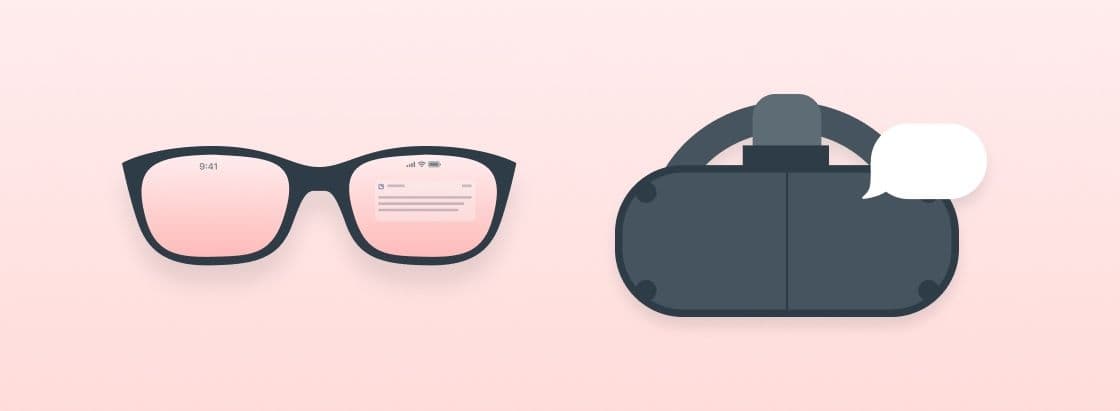
When it comes to frontier tech, Augmented Reality (AR) and Virtual Reality (VR) notifications are about as frontier as you can get these days without veering into pure science fiction. Both technologies exist and have some level of customer adoption, but what messaging will look like on these platforms is still up in the air. For AR, it comes down to what the major devices end up being for this kind of technology: If we continue to engage with AR primarily through phones (think mobile makeup previews and AR-powered mobile gaming), then common mobile messaging channels like push notifications will probably suffice to keep users engaged; if headsets or AR-enabled glasses/goggles become the standard, new approaches will likely be needed.
On the VR messaging front, it’s clear that we’re still a ways away from an agreed-upon messaging model. Back in 2016, one of the earliest consumer VR devices launched a smartphone app to allow people to receive phone notifications while immersed in VR; however, that functionality was limited to incoming calls, text messages, and calendar reminders. Some newer devices support notifications, but not all of them can be opened inside the VR environment.
In 2018, the Institute of Electrical and Electronics Engineers (IEEE) Transactions on Visualization and Computer Graphics published a paper noting that VR lacked a standard notification management system and highlighted the lack of clarity around how notifications can and should work in a fully immersive VR environment. On the one hand, users will need reminders about important real-world information—otherwise, they may well find themselves missing important calls or appointments, or injuring themselves because they aren’t aware of nearby dangers (e.g. “Careful, you’re about to fall down the stairs!”). On the other, a virtual world that features just as many distractions and notifications as your real one is unappealing for most consumers. Until more foundational work is complete, VR messages will likely remain more of a concept than an actual, usable channel.
The Verdict: Way, way out—wait until AR/VR adoption is stronger and messaging concepts have been fleshed out before investing any time or energy here.
Final Thoughts
No brand can see the future. But marketing, growth, and engagement teams that keep an eye on the customer engagement landscape and its evolution have an opportunity to meet tomorrow’s challenges and leverage tomorrow’s channels more effectively to reach and build relationships with their customers.
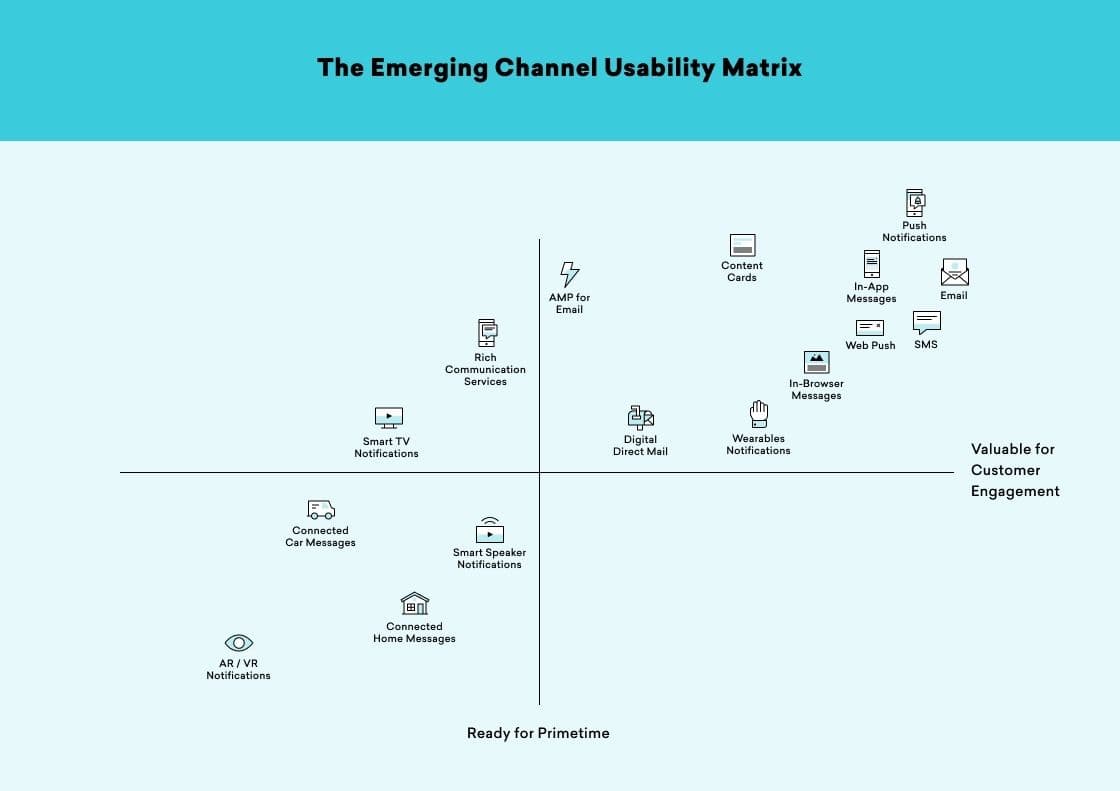
Channels are central to how brands speak to their audience, but the way forward isn’t a channel-centric arms race where whatever brand that uses the most wins—ultimately, messaging channels are a way of communicating with your company’s unique audience. Figuring out what channels speak to which customers and how best to deploy each one takes care, thought, and a fair amount of testing.
To learn more about how to how to move beyond a single-channel approach to marketing into a customer-first, cross-channel strategy, check out our Braze Brand Humanity Index (BHI) guide and BHI data report.
Related Tags
Be Absolutely Engaging.™
Sign up for regular updates from Braze.
Related Content
View the Blog
How AI Decisioning Transforms Marketing (A Complete Guide)

Team Braze

AI decisioning cheat sheet: How to crawl/walk/run with BrazeAI Decisioning Studioᵀᴹ

Team Braze

A day in the life of a data scientist on the BrazeAIᵀᴹ forward-deployed engineering team
